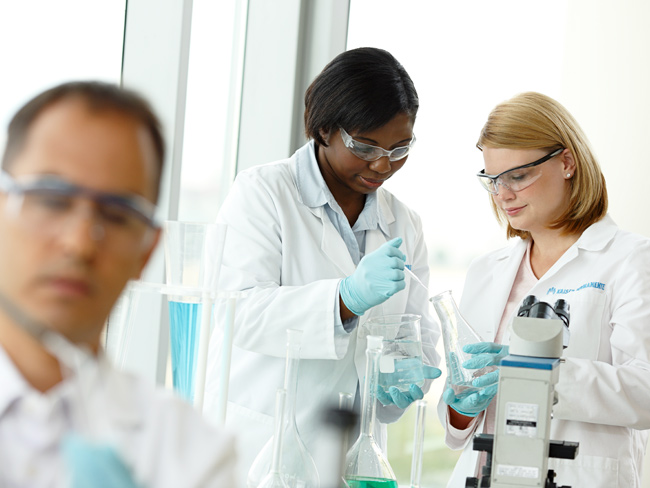Meeting needs in the pandemic
The third year of COVID-19 highlights our people’s resilience and commitment to caring for others.
The third year of the COVID-19 pandemic began with the ongoing surge of the omicron variant. This brought the fastest spread of the coronavirus since it first appeared. The asymptomatic nature of many omicron infections triggered a spike in demand for COVID-19 testing. Fortunately, during the rest of 2022, no significant new variants emerged to cause substantial increases in hospitalizations, severe new forms of illness, or deaths. Across the country, there were fewer deaths from COVID-19 in 2022 than in each of the prior 2 years of the pandemic, although the virus continued to be the third-leading cause of death in America. Tragically, by the end of 2022 more than 1 million people in the United States had died from COVID-19 since the pandemic began.
Even as our communities began to return to normalcy in 2022, health care continued to experience challenges. Across the country, health care organizations struggled to deliver 3 years’ worth of delayed care. Health care providers also worked tirelessly to address a dramatic increase in demand for mental health services, while continuing to manage care for COVID-19 patients. As we entered the winter months of 2022 — with flu, respiratory syncytial virus (RSV), and COVID-19 on the rise — our country’s health care system became even more strained.
2022: A year of ongoing strain
1.8M
Patients with COVID-19 cared for (including 53,000 inpatients)
5M
Vaccine doses administered (including boosters) to members and nonmembers
7M
COVID-19 lab tests conducted and 14.2 million home antigen tests provided
While they battled COVID-19, our care teams treated more than 328,000 patients with the flu and more than 17,000 patients with RSV. Our teams also delivered inpatient care to nearly 41,000 patients with the flu and more than 3,400 patients with RSV.
At Kaiser Permanente, we experienced a high demand for care while, at times, working with fewer staff members due to a nationwide shortage of health care workers. Staffing shortages increased when health care workers experienced the same illnesses as the communities they served and needed to stay home. To meet growing care needs, we adjusted how we work and aggressively addressed the industrywide staffing shortages. We increased in-person and virtual appointments, and where possible, extended medical office hours. We also launched new services and capabilities to provide 24/7 access to care for members at home and when they travel. The same extraordinary and dedicated people of Kaiser Permanente, who navigated the toughest challenges of the pandemic to deliver care, remained deeply committed to our members’ health and the health of our communities.
Vaccination efforts
Kaiser Permanente has been at the forefront of the COVID-19 vaccination campaign since it began in late 2020. We demonstrated that we could act quickly and effectively to provide vaccinations to our members and communities. We continued that leadership through 2022, including partnering with trusted community organizations to combat misinformation, provide education about the benefits of the vaccine, and ensure that disadvantaged and at-risk populations could access the vaccine. Throughout 2022, Kaiser Permanente safely delivered more than 5 million vaccine doses to our members and communities.
In the fall of 2022, the Centers for Disease Control and Prevention recommended that people age 5 and older get an updated (or bivalent) COVID-19 booster for better protection against the most prevalent omicron variants. These variants caused most COVID-19 cases in the U.S. that year. Vaccination is essential to preventing serious illness and hospitalization, not just for COVID-19 but also for the flu and other diseases. Our infectious disease experts know that the best way to protect yourself, your family, and our communities is to get vaccinated and boosted.
In the future, we expect to see an evolution of new COVID-19 variants, as well as the emergence of new viruses and infections. But with advances in medical technology, such as the mRNA vaccines, we have powerful tools to manage these diseases and minimize their impact. When Paxlovid became available as a treatment for people who contracted COVID-19, our team moved quickly to establish an efficient process for distributing this medication to individuals at high risk for severe illness.
Testing for COVID-19
Throughout 2022, Kaiser Permanente conducted nearly 7 million COVID-19 lab tests nationally and provided our members and communities with more than 14.2 million home antigen tests. Early in the COVID-19 pandemic, PCR lab tests were almost always used to detect the virus. As antigen tests became widely available, by the end of 2022 it was easier and faster to get test results at home. In most cases, home antigen tests or self-tests — the kind sold over the counter — became the best option for quick results (in 30 minutes or less) without a trip to a medical facility. In those cases where clinical circumstances called for a PCR test, we made it easier for our members to get tested and get results quickly.
Keeping front-line caregivers safe
The ongoing impact of this pandemic included the increased demand for mental health care and care that was delayed during the heart of the pandemic. These factors made 2022 another challenging and stressful time to work on the front lines of health care.
Early in the pandemic response, Kaiser Permanente took extraordinary steps to support and protect our workforce. This included providing $800 million in employee assistance to ensure that employees had access to alternate housing options, special child care grants, and additional paid leave for COVID-19 illness and exposure. We appreciated the ongoing partnership of the unions, which represented our employees during 2022. Our labor partners helped strengthen our ongoing pandemic response.
As the COVID-19 pandemic evolved, we addressed burnout and exhaustion among our workforce. And we continue to support and protect our people. Their commitment to caring for our members, patients, and communities throughout the pandemic has been so inspiring. We continue to thank them for their resilience and compassion. We celebrate their expertise and accomplishments during this historic time.
Research
Our scientists, researchers, and infectious disease experts responded to this crisis with unwavering determination. They continue to learn and share their knowledge with the world.
During the pandemic, Kaiser Permanente doctors and researchers participated in the initial research for the Pfizer COVID-19 vaccine. And we helped demonstrate both the safety and effectiveness of this vaccine against COVID-19. Kaiser Permanente teams were also involved in multiple studies, including a study on Remdesivir, an antiviral for COVID-19, which has also proven to be extremely effective. In 2022, our doctors and researchers continued to conduct important research on COVID-19 including multiple studies on vaccine safety and effectiveness, COVID-19 and pregnancy complications, and the impact of exercise on the severity of COVID-19 outcomes.
Protecting the health of our communities
We’re especially focused on improving the health of communities most harmed by the pandemic.
Race, ethnicity, gender, sexual orientation, and socioeconomic status shouldn’t matter when it comes to accessing care and staying healthy. However, the pandemic highlighted long-standing inequities in health care across the nation for people in many underserved communities. These disparities have existed for many years but received new attention during the COVID-19 pandemic.
Kaiser Permanente has always had a deep and abiding commitment to health equity, long before this pandemic. Nearly 40% of our membership is people of color, and our members speak more than 130 languages. Our workforce reflects the diversity of the communities we serve. For more information on our work across a wide range of health equity initiatives, see our Annual Report section on Health Equity.
We continue to participate in discussions on local, state, and federal policies affecting the health of our communities. We worked with public health agencies at all levels, demonstrating the value of public-private partnerships to better confront shared challenges. We joined efforts to explore ideas for improving our nation’s public health infrastructure, with the aim of ensuring that our country is prepared for the next public health crisis. By working together to build the best of what we’ve learned into our nation’s health care and public health infrastructure, we’ll be even stronger and better prepared for future challenges. For more information on our work across a wide range of community health initiatives, see our 2022 Community Health Snapshot.
Moving forward together
The pandemic changed us all forever — as people, as communities, and as a nation. We've all felt the personal loss and uncertainty that COVID-19 brought into our lives. As it moves from a global pandemic to an endemic reality, the virus will remain in our communities. Kaiser Permanente’s highest priority remains the health, safety, and well-being of our employees, physicians, members, and the communities we serve.
We are honored to have been able to serve and care for our members, patients, and their families during the pandemic. We appreciate the many dedicated organizations in our communities that helped deliver care, comfort, social services, support, and trusted information to the most vulnerable people we serve. It bears repeating that we offer our deepest gratitude and admiration for our physicians, care teams, and employees for the great work they did in 2022 to care for our members, patients, community, and each other. They make it possible for Kaiser Permanente to deliver on its mission.





